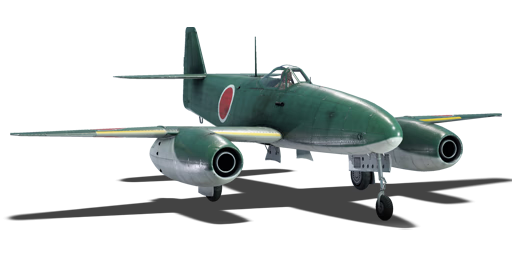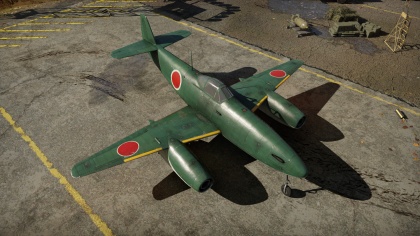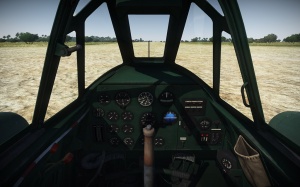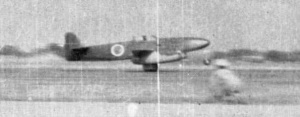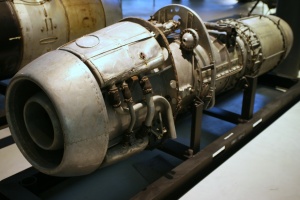Difference between revisions of "Kikka"
(Updated information.) |
Ffffffffool (talk | contribs) (→Pros and cons: good vertical performance, and word change) (Tag: Visual edit) |
||
| Line 131: | Line 131: | ||
=== Survivability and armour === | === Survivability and armour === | ||
<!--''Examine the survivability of the aircraft. Note how vulnerable the structure is and how secure the pilot is, whether the fuel tanks are armoured. Describe the armour, if there is any, also mention the vulnerability of other critical aircraft systems.''--> | <!--''Examine the survivability of the aircraft. Note how vulnerable the structure is and how secure the pilot is, whether the fuel tanks are armoured. Describe the armour, if there is any, also mention the vulnerability of other critical aircraft systems.''--> | ||
| + | |||
* 70 mm Bulletproof glass - Armored windscreen | * 70 mm Bulletproof glass - Armored windscreen | ||
* 12.7 mm Steel plates in front of front fuel tank | * 12.7 mm Steel plates in front of front fuel tank | ||
| Line 148: | Line 149: | ||
<!--=== Suspended armament === | <!--=== Suspended armament === | ||
''Describe the aircraft's suspended armament: additional cannons under the wings, bombs, rockets and torpedoes. This section is especially important for bombers and attackers. If there is no suspended weaponry remove this subsection.''--> | ''Describe the aircraft's suspended armament: additional cannons under the wings, bombs, rockets and torpedoes. This section is especially important for bombers and attackers. If there is no suspended weaponry remove this subsection.''--> | ||
| + | |||
''Main article: '''[[:Category:Suspended armaments|Bombs]]''''' | ''Main article: '''[[:Category:Suspended armaments|Bombs]]''''' | ||
| Line 196: | Line 198: | ||
===Modules=== | ===Modules=== | ||
{| class="wikitable" | {| class="wikitable" | ||
| − | !colspan = "1"| Tier | + | ! colspan="1" | Tier |
| − | !colspan = "2"| Flight performance | + | ! colspan="2" | Flight performance |
| − | !colspan = "1"| Survivability | + | ! colspan="1" | Survivability |
| − | !colspan = "2"| Weaponry | + | ! colspan="2" | Weaponry |
|- | |- | ||
| I | | I | ||
| Line 230: | Line 232: | ||
|- | |- | ||
|} | |} | ||
| + | |||
* [[File:FighterImage_180px-Otsu.png|thumbnail|none|The Otsu modification unlock allows the installation of a second 30 mm Type 5 cannon.]] | * [[File:FighterImage_180px-Otsu.png|thumbnail|none|The Otsu modification unlock allows the installation of a second 30 mm Type 5 cannon.]] | ||
| + | |||
=== Pros and cons === | === Pros and cons === | ||
<!--''Summarize and briefly evaluate the vehicle in terms of its characteristics and combat effectiveness. Mark its pros and cons in the bulleted list. Do not use more than 6 points for each of the characteristics. Avoid using categorical definitions such as "bad", "good" and the like - they have a substitution in the form of softer "inadequate", "effective".''--> | <!--''Summarize and briefly evaluate the vehicle in terms of its characteristics and combat effectiveness. Mark its pros and cons in the bulleted list. Do not use more than 6 points for each of the characteristics. Avoid using categorical definitions such as "bad", "good" and the like - they have a substitution in the form of softer "inadequate", "effective".''--> | ||
'''Pros:''' | '''Pros:''' | ||
| + | |||
* Early jet fighter that can frequently see prop aircraft | * Early jet fighter that can frequently see prop aircraft | ||
* Can carry a large 800kg Naval bomb | * Can carry a large 800kg Naval bomb | ||
| Line 240: | Line 245: | ||
* Good at diving as long as it has enough performance modules | * Good at diving as long as it has enough performance modules | ||
* 30 mm cannons are hard hitters | * 30 mm cannons are hard hitters | ||
| − | * Good climb rate | + | * Good climb rate and vertical performance |
* Great energy retention | * Great energy retention | ||
'''Cons:''' | '''Cons:''' | ||
| + | |||
* Limited ammo, only 50 shells per gun | * Limited ammo, only 50 shells per gun | ||
| − | * Poor turn | + | * Poor turn rate |
* Only one 30 mm gun when stock | * Only one 30 mm gun when stock | ||
* Adding payload will hinder handling significantly | * Adding payload will hinder handling significantly | ||
| Line 266: | Line 272: | ||
== Read also == | == Read also == | ||
''Links to the articles on the War Thunder Wiki that you think will be useful for the reader, for example,'' | ''Links to the articles on the War Thunder Wiki that you think will be useful for the reader, for example,'' | ||
| + | |||
* ''reference to the series of the aircraft;'' | * ''reference to the series of the aircraft;'' | ||
* ''links to approximate analogues of other nations and research trees.'' | * ''links to approximate analogues of other nations and research trees.'' | ||
| Line 272: | Line 279: | ||
== Sources == | == Sources == | ||
''Paste links to sources and external resources, such as:'' | ''Paste links to sources and external resources, such as:'' | ||
| + | |||
* ''topic on the official game forum;'' | * ''topic on the official game forum;'' | ||
* ''page on aircraft encyclopedia;'' | * ''page on aircraft encyclopedia;'' | ||
Revision as of 15:34, 19 May 2019
Contents
Description
The Kikka is a Rank V Japanese jet fighter
with a battle rating of 6.7 (AB/SB) and 7.0 (RB). It was introduced in Update 1.43.
The Kikka is a well-armed and powerful fighter-bomber. The Kikka starts out with a single 30 mm and you will have to research the 'otsu' mod before you can obtain the second 30 mm. It is important you utilize your speed to your advantage, as that is its biggest advantage against most aircraft it encounters. A good turner in high speeds, but in low speeds you may find it difficult to turn as well as to regain your speed. Always maintain an energy advantage over your enemies, so you can quickly engage and disengage your targets. Never try to keep on them unless you know you have the advantage. It is recommended you do not 'head-on' other targets until you have acquired the Otsu mod. The Kikka is a very durable and well armoured aircraft, so it can take a multiple hits in a head-on.
Regarding its bombing capabilities, it makes the Kikka significantly slower and can be difficult to control. Speed is a must with the Kikka, and it is recommended you perform high-speed dive bombing to ensure the destruction of your target and to escape pursuers. The speed you gained in your dive can be maintained by your now unburdened plane. Make sure to use the rocket boosters to take off or else the aircraft will have significant difficulty taking off with bombs equipped and be unable to retract the landing gear.
General info
Flight Performance
| Characteristics | |||||||
|---|---|---|---|---|---|---|---|
| Stock | |||||||
| Max Speed (km/h at 3,000 m) |
Max altitude (meters) |
Turn time (seconds) |
Rate of climb (meters/second) |
Take-off run (meters) | |||
| AB | RB | AB | RB | AB | RB | ||
| 772 | 753 | 12500 | 27.0 | 27.7 | 17.0 | 16.2 | 750 |
| Upgraded | |||||||
| Max Speed (km/h at 3,000 m) |
Max altitude (meters) | Turn time (seconds) | Rate of climb (meters/second) |
Take-off run (meters) | |||
| AB | RB | AB | RB | AB | RB | ||
| ? | ? | 12500 | ??.? | ??.? | ??.? | ??.? | 750 |
Details
| Features | ||||
|---|---|---|---|---|
| Combat flap | Take-off flap | Landing flap | Air brakes | Arrestor gear |
| ✓ | ✓ | ✓ | X | X |
| Limits | ||||
|---|---|---|---|---|
| Wing-break speed (km/h) |
Gear limit (km/h) |
Combat flap (km/h) |
Max Static G | |
| + | - | |||
| 980 | 380 | 580 | ~25 | ~11 |
| Optimal velocities | |||
|---|---|---|---|
| Ailerons (km/h) |
Rudder (km/h) |
Elevators (km/h) |
Radiator (km/h) |
| < 590 | < 590 | < 650 | > 250 |
Survivability and armour
- 70 mm Bulletproof glass - Armored windscreen
- 12.7 mm Steel plates in front of front fuel tank
- 12.7 mm Steel plate behind the pilot
- 12.7 mm Steel plate behind the rear fuel tank
Armaments
Offensive armament
The Kikka is armed with:
- A choice between one or two 30 mm Type 5 cannons:
- 1 x 30 mm Type 5 cannon, nose-mounted (50 rpg)
- 2 x 30 mm Type 5 cannons, nose-mounted (50 rpg = 100 total)
Main article: Bombs
The Kikka can be outfitted with the following ordnance:
- Without load
- 1 x 500 kg Navy Type Number 50 Model 2 bomb (500 kg total)
- 1 x 800 kg Navy Type Number 80 Model 1 bomb (800 kg total)
Usage in the battles
The Kikka has the weakest jet engine in-game. This translates into a slow acceleration, poor climb rate, and low top speed for a jet. The pilot is quite heavily protected from the front and rear by both armour and self sealing fuel tanks. The wing mounted engines on the other hand take damage easily and minor damage to them will further slow down your plane to speeds that even props can match.
The guns are very powerful and can down fighters in a few solid shots, but they often spark.
The Kikka should be played as a Boom & Zoomer. It has a good roll rate so it can still catch enemies that attempt to dodge your attack. Pursuers can be outrun by going into a slight dive.
Most jets are a significant threat to the Kikka. As noted earlier, it has weak engines so aside from the Yak-15 and Yak-17 all other jets will be able to catch up to it.
Super props like the P-51H-5NA can also catch the Kikka.
To attempt to gain the upper hand on a Kikka, propeller planes should dive from at least 2,000 m above the Kikka to be able to catch the it. If the Kikka goes into a turn fight, it will generally severely bleed its energy making it an easy target to be defeated by the prop plane.
Modules
| Tier | Flight performance | Survivability | Weaponry | ||
|---|---|---|---|---|---|
| I | Fuselage Repair | 14 in (mod41) | |||
| II | Engine | Airframe | Offensive 30 mm | ||
| III | Wings Repair | Otsu mod. | |||
| IV | Cover | New 30 mm Cannons | |||
- File:FighterImage 180px-Otsu.pngThe Otsu modification unlock allows the installation of a second 30 mm Type 5 cannon.
Pros and cons
Pros:
- Early jet fighter that can frequently see prop aircraft
- Can carry a large 800kg Naval bomb
- Can use flaps at high speeds (roughly 550 km/h = 341 mph)
- Good at diving as long as it has enough performance modules
- 30 mm cannons are hard hitters
- Good climb rate and vertical performance
- Great energy retention
Cons:
- Limited ammo, only 50 shells per gun
- Poor turn rate
- Only one 30 mm gun when stock
- Adding payload will hinder handling significantly
- Slow for a jet
- Prop planes will out turn you
- Poor cockpit visibility with an extremely crude aiming sight
History
The Nakajima Kikka or Kitsuka as it is also known, was Japan's first entirely jet-powered aircraft, based loosely on the information they had received on the German Me 262 Schwalbe. Whilst the clear resemblance can be seen, the Japanese were not able to receive all of the information that was provided through a negotiation on 1944 with the German high command over the licencing for plans on both the Me 262, BMW 003 and Junkers Jumo 004 Turbojet engines. Examples and plans were lost with the sinking on a I-29 Submarine that carried the important cargo, however all was not completely lost. Parts of the designs were saved as they were flown in to Japan separate from the Submarine. Upon further inspection of the BMW 003A plans, the Japanese designers found it somewhat similar to their own Ne 12, with the major differences being the German engine used a axial-flow compressor rather than a centrifugal compressor.
Work began on newer engine designs. but ultimately the Ishikawajima Ne 20 engine was the one selected which was an indigenous Japanese design based on the knowledge of the German engines. The Kikka would be noticeably smaller than the German design, with more straight wings as opposed to the swept back leading edge of the Schwalble. Rather than the 4 x 30 mms cannons on the 262, the Kikka would use just one or two Type 5 30 mm cannons. The ever increasing pressure from the B-29 raids ensured that aircraft such as the Kikka were a high priority for the Japanese as interceptor aircraft. However the aircraft would not fly until August 7th 1945, by which time, the Japanese were rapidly running out of time. It would fly again on the 11th August 1945, suffering a crash landing which damaged the aircraft and its engines severely. That would be the last time the aircraft would fly again as just days later, the surrender of Japan was broadcast over the radio, signaling the end of the Kikka development.
Media
An excellent addition to the article will be video guides, as well as screenshots from the game and photos.
Read also
Links to the articles on the War Thunder Wiki that you think will be useful for the reader, for example,
- reference to the series of the aircraft;
- links to approximate analogues of other nations and research trees.
Sources
Paste links to sources and external resources, such as:
- topic on the official game forum;
- page on aircraft encyclopedia;
- other literature.
| Japan jet aircraft | |
|---|---|
| IJNAS | |
| Experimental | Kikka |
| Reconnaissance | R2Y2 Kai V1 · R2Y2 Kai V2 · R2Y2 Kai V3 |
| IJAAS | |
| Fighters | Ki-200 |
| JASDF | |
| Fighters | F-86F-30 ▅ · F-86F-40 ▅ · F-86F-40 JASDF▅ |
| F-104J | |
| F-4EJ Phantom II · F-4EJ ADTW · F-4EJ Kai Phantom II | |
| F-15J | |
| F-16AJ | |
| F-1 | |
| Trainers | T-2 Early · T-2 |
| Foreign | |
| Thailand | ▄F-5E FCU |


